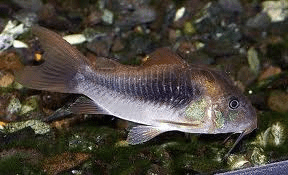
Common Name: Palespotted Corydoras Catfish
Scientific Name: Corydoras Gossei
Average Adult Fish Size: 2 inches / 5 cm
Place of Origin: Amazon, South America.
Typical Tank Setup: These bottom dwellers will like plenty of bogwood and some rocks as well as much vegetation and planted aquarium is a must for these Corydoras.
Recommended Minimum Aquarium Capacity: 30 gallon / 120 litre
Compatibility: The Corydoras species is perfect for the community aquarium as a bottom dweller and as such will be compatible with other community fish such as tetras. It is a very peaceful fish and so care should be taken not to introduce aggressive fish with it but will generally keep itself to itself and spend it’s whole time scavenging the bottom of the tank.
Temperature: 22 – 26 Deg C / 72 – 79 Deg F
Water Chemistry: pH 5.8 – 7.0
Feeding: In the aquarium environment Palespotted Cory Cats will readily accept a variety of meaty and vegetable matter foodstuffs including: flake, freeze-dried, frozen, live foods and pellets. This species is an excellent scavenger that will work to keep the aquarium substrate clean of excess foodstuffs and some decaying plant matter.
Sexing: Male corydoras are generally smaller and slimmer, females are larger and rounder, true for all cories. It takes a while of observing them every day and getting to know them and then it gets fairly easy to sex them.
Breeding: The corydoras catfish need to be happy with their environment and surroundings to be in a position to and happy to breed in the home aquarium so it is important to give them some but not too many hiding places and to not change the tank around too much so they have a chance to settle. You should also ensure water parameters are at an optimum level, we would recommend the following:
- 0 ppm Ammonia
- 0 ppm Nitrite
- 10 ppm Nitrate
This can mean plenty of small water changes to ensure optimum parameters are adhered to.
Now you have the tank as they should like it you must condition the Corydoras themselves. The key to doing this is to feed them plenty of live food such as blackworms or bloodworms as well as doing cold water changes.
This should spark the Corydoras in to a state of wanting to breed and you will be able to tell as the female will be getting fat (this means she is filling up with eggs). The male will then follow the female around like her shadow and not leave her alone.
Continue with the water changes, never more than 40% and you will continue to notice breeding activity such as chasing and you could witness them forming a T shape which is when the eggs are actually fertalised.
Ultimately you are trying to simulate the rainy season to try to spur on breeding with the Cory catfish.
Additional Information: The Corydoras catfish are very popular now in the aquarium trade for community aquariums which we believe is down to their favourable size and the personality they posses of a fish which is active and seems to always have something to be doing!


Related Posts
Croaking Gourami – Trichopsis vittatus
Paradise Fish – Macropodus opercularis
Schubert’s Barb – Barbus Semifasciolatus